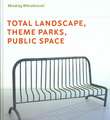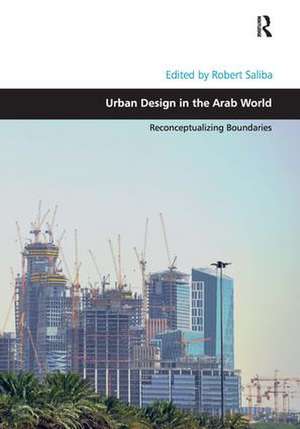Urban Design in the Arab World: Reconceptualizing Boundaries: Design and the Built Environment
Autor Robert Salibaen Limba Engleză Hardback – 28 iun 2015
Din seria Design and the Built Environment
-
 Preț: 340.38 lei
Preț: 340.38 lei - 18%
 Preț: 1027.58 lei
Preț: 1027.58 lei - 14%
 Preț: 338.33 lei
Preț: 338.33 lei -
 Preț: 492.20 lei
Preț: 492.20 lei - 14%
 Preț: 338.33 lei
Preț: 338.33 lei -
 Preț: 469.34 lei
Preț: 469.34 lei -
 Preț: 469.34 lei
Preț: 469.34 lei - 13%
 Preț: 338.33 lei
Preț: 338.33 lei -
 Preț: 471.42 lei
Preț: 471.42 lei -
 Preț: 349.10 lei
Preț: 349.10 lei -
 Preț: 489.26 lei
Preț: 489.26 lei -
 Preț: 469.34 lei
Preț: 469.34 lei - 14%
 Preț: 260.54 lei
Preț: 260.54 lei - 16%
 Preț: 301.97 lei
Preț: 301.97 lei - 15%
 Preț: 259.10 lei
Preț: 259.10 lei - 12%
 Preț: 328.00 lei
Preț: 328.00 lei - 25%
 Preț: 827.24 lei
Preț: 827.24 lei -
 Preț: 389.31 lei
Preț: 389.31 lei - 18%
 Preț: 1006.43 lei
Preț: 1006.43 lei - 18%
 Preț: 1110.77 lei
Preț: 1110.77 lei -
 Preț: 382.75 lei
Preț: 382.75 lei -
 Preț: 416.22 lei
Preț: 416.22 lei - 17%
 Preț: 246.33 lei
Preț: 246.33 lei - 28%
 Preț: 800.60 lei
Preț: 800.60 lei
Preț: 768.79 lei
Preț vechi: 1105.48 lei
-30% Nou
Puncte Express: 1153
Preț estimativ în valută:
147.12€ • 159.76$ • 123.59£
147.12€ • 159.76$ • 123.59£
Carte tipărită la comandă
Livrare economică 22 aprilie-06 mai
Preluare comenzi: 021 569.72.76
Specificații
ISBN-13: 9781472409768
ISBN-10: 1472409760
Pagini: 296
Dimensiuni: 174 x 246 mm
Greutate: 0.71 kg
Ediția:1
Editura: Taylor & Francis
Colecția Routledge
Seria Design and the Built Environment
Locul publicării:Oxford, United Kingdom
ISBN-10: 1472409760
Pagini: 296
Dimensiuni: 174 x 246 mm
Greutate: 0.71 kg
Ediția:1
Editura: Taylor & Francis
Colecția Routledge
Seria Design and the Built Environment
Locul publicării:Oxford, United Kingdom
Cuprins
Urban Design in the Arab World
Notă biografică
Robert Saliba is a Professor at the Department of Architecture and Design, the American University of Beirut, and served as the coordinator of the graduate program in Urban Planning and Policy and Urban Design between 2008 and 2011. He has conducted extensive research on Beirut's historic formation and postwar reconstruction, and published three reference monographs: Beyrouth Architectures: Aux Sources de la Modernité (Parenthèses 2009), Beirut City Center Recovery: the Foch-Allenby and Etoile Conservation Area (Steidl 2004), and Beirut 1920-1940: Domestic Architecture between Tradition and Modernity (The Order of Engineers and Architects 1998). He has served as a land use consultant with the World Bank and UN-Habitat on the state of the environment in Lebanon and worked as an urban design consultant and a city planning associate at the Community Redevelopment Agency in Los Angeles, California.
Recenzii
’Most urban designers are familiar with the historical architecture of Islam and its current contribution to postmodernity, particularly in the United Arab Emirates. Less well known however is the singular contribution it has made to urban design. This text contributes a new dimension to our understanding of urban space and form and its links to globalisation, regionalism, culture, and religion. It brings together unique expertise to reveal the much neglected complexity of urbanism in the Arab world.’ Alexander Cuthbert, The University of New South Wales, Australia ’The Arab City, a post-Islamic city concept, is the prism through which this collection of essays examines both the practice of urban design and the various discursive frameworks shaping it today. Deftly deploying critical, poststructuralist, and postcolonial theories, the book manages to pose fundamental questions about the status of urbanism, design, and politics before and after the Arab Spring.’ Nasser Rabbat, Massachusetts Institute of Technology, USA
Descriere
Providing a critical overview of the state of contemporary urban design in the Arab World, this book conceptualizes the field under four major perspectives: urban design as discourse, as discipline, as research, and as practice. It poses the questions: how can such a diversity of practice be positioned with regard to current international trends in urban design? And what constitutes the specificity of the Middle Eastern experience in light of the regional political and cultural settings? This book is also about urban designers ’on the margins’: how they narrate their cities, how they engage with their discipline, and how they negotiate their distance from, and with respect to global disciplinary trends.
